

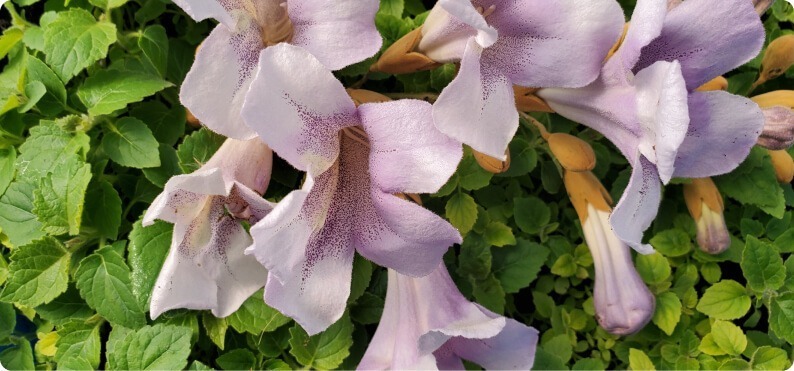
Paulownia is a unique species of fast-growing tree without equal in the world. In the sections of our website, you can find information regarding this fascinating species. Learn a little more about its cultural, historical, environmental aspects and, also, discover how to purchase our products.
This tree comes from the Asian continent, specifically China. The date of this species, according to written documents that mention its use, is before 2600 BC. For centuries, the tree grew in Japan, where it is also called Kiri tree , a word that in Japanese means “life.” The Kiri has always been considered a sacred tree and also a symbol of luck.
According to tradition, after the birth of a daughter in the family, a Paulownia tree was planted and, during the development of the girl, the growth of the tree accompanied her. When she became a woman and got married, she cut down the tree and its wood was used to make her wedding trunk. Another belief, which speaks more about fortune and good luck, indicated that, if a Paulownia was planted next to a house, a phoenix would perch on its branches, thus bringing happiness to that house.
The tradition has been maintained over time and has transcended Japan, since its use has been documented since at least 200 AD and is a national asset. In this culture, tribute is paid to its aesthetics , as well as its symbolism. That is why today its cultural importance has made it the image of different official emblems of the country.
| Several of the examples include the use of the image of the Paulownia as the emblem of the minister’s office . Additionally, the Paulownia leaf is depicted on the Japanese 500 yen coin . | Another proof of its national importance, its image is placed on the symbol of the Order of the Rising Sun , which was established in 1875, and is an award given to citizens for their service to the country as admirals, generals, diplomats or politicians. |

On the other hand, in 1823, Phillip Von Siebold, a German naturalist, visited Japan and upon returning to Holland, he took Kiri seeds with him. And the question arose: How would I name such a fascinating plant?
Unsurprisingly, it was named after the beloved Queen of Holland, Anna Pavlovna Romanova , the sixth daughter of Tsar Paul I and Empress Maria Fedorovna. It was impossible to name the plant “Anna”, since it already existed. Then it was decided to use the patronymic “Anna”, which, in European terms, is adopted as a middle name: “Paulownia”, to name the plant.
Anna Pavlovna helped the German naturalist finance an expedition to Southeast Asia. She later, she together with Josef Zuccarini, published the book “ Flora Japonica ”, where the properties and qualities of the tree were described for the first time. The Japanese liked the European name, and they also began to call this beautiful tree: Paulownia .
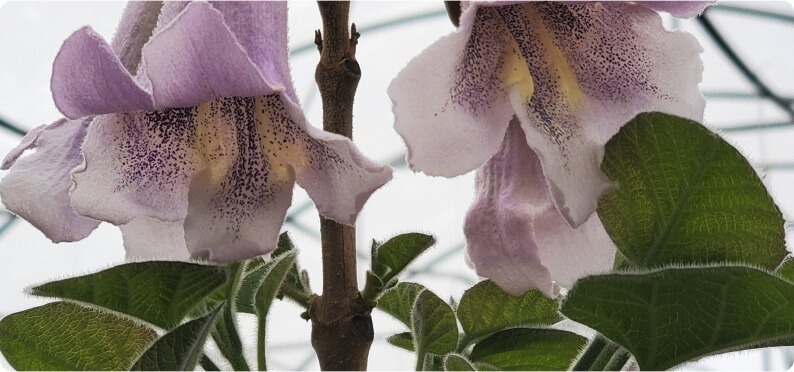
In China, Paulownia is cultivated in an area of 2.5 million hectares , of which 1.3 million hectares are cultivated in combination with other plants. It is combined with crops such as cotton, corn, tea, etc.
You may have come across this extravagant tree with its huge leaves and fragrant flowers in the city park. But they would never have thought that this beauty is not only aesthetically attractive, but also has many beneficial qualities and properties in different fields.
The Paulownia, also called Adam’s tree or tree of life, belongs to the “Paulowniaceae” plant family. This family contains more than 20 species with similar qualities, which is why they are collectively named Paulownia: P. australis, P. catalpifolia, P. korea, P. duclouxii, P. elongate, P. fargesii, P. fortune, P. glabrata, P. grandifolia, P. imperialis, P. kawakamii, P. lilacina, P. longifolia, P. meridionalis, P. Mikado, P. recurva, P. rehderiana, P. shensiensis, P. silvestrii, P. taiwaniana, P. thyrsoidea, P. tomentosa and P. viscose. We will talk about some of the characteristics that are common among all or almost all Paulownia species.
It is a tree with large, beautiful leaves, with a diameter of up to 70 centimeters, flowers up to 6 centimeters in diameter and a beautiful crown. The diameter of the stem in Paulownia can reach up to one meter in length. The growth of these trees depends on the environment where they grow, but some species can reach 30 meters in height. This plant is not especially demanding in terms of the necessary soil conditions to develop. However, its development is optimal in deep, moderately humid, drained or sufficiently fertile and clayey soils. It prefers open, lighted areas, and can develop as a large multi-stemmed shrub.
Regarding its growth, it is considered a fast growing tree . Although this characteristic is more noticeable within its first years of life, after which its growth slows down. At this point (around its fifth year) the tree’s stem can increase in diameter by up to 1 centimeter per year.
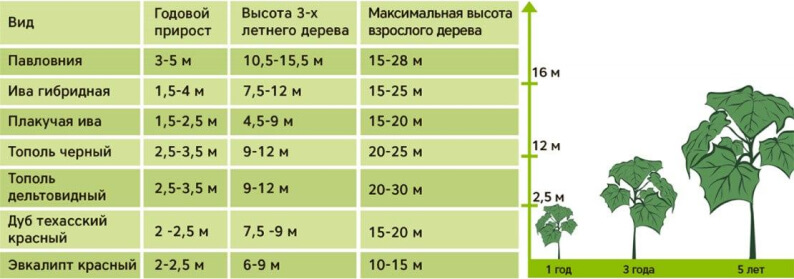
One of the singularities of the Paulownia is the fact that this tree does not need replanting. This is because after each pruning, the tree regenerates . It is important to note that the useful life of the root is 70-100 years, which means that it can be used between four and nine 8-year cycles.
In terms of plantations and crops, it means that it is possible to resume the work process without the need to invest again in planting. In addition, the trunk can be felled at any time of the year, which differentiates it from other tree species.
During the first year the tree has large leaves , which depending on the species, can measure up to 85 centimeters. Its leaf has rounded edges and is egg or heart shaped. They are bright green and are often hairy on top and velvety on the underside. When the leaves fall from the tree they remain green, although after falling, they turn brown.
They have a cylindrical-pyramidal shape with cymes of up to 8 flowers, with or without peduncles.
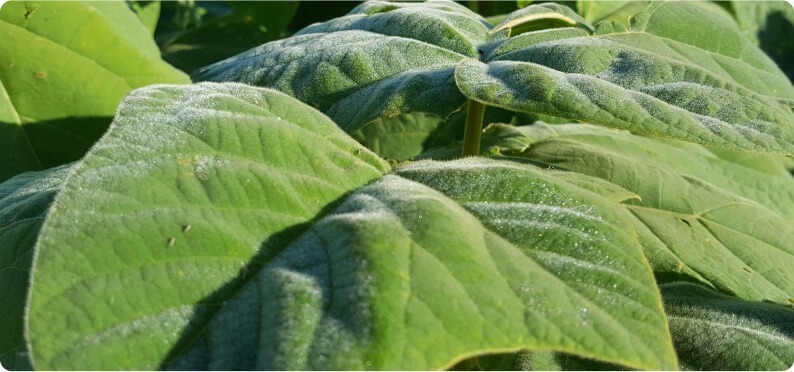
This process begins in spring and lasts 6-8 weeks. The calyx of the flower is bell-shaped, with five sepals of similar size, although the upper one is usually somewhat larger. The corolla of the flower can be purple or white, bell-shaped with a narrow and slightly curved tube base. The flowers are usually grouped in large panicles of up to 30 flowers.
They are small, usually numerous, with membranous wings, which makes them similar to the wings of a butterfly, they can measure around 2 to 7 millimeters and they have anemochorous dispersal , which means that it is the wind that is responsible for dispersing them. .
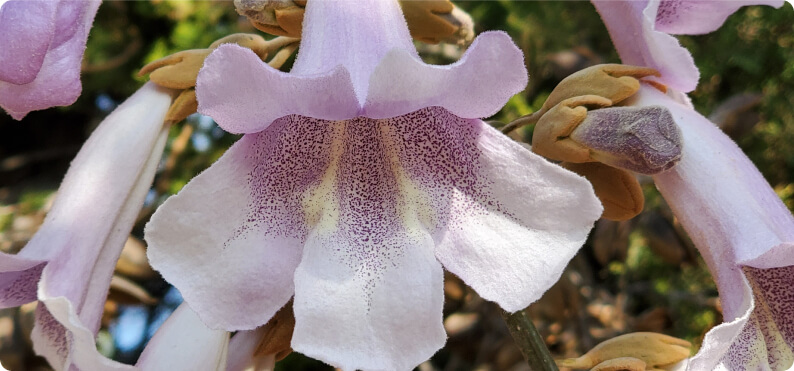
Adventitious or anchor roots. They can reach 4 to 9 meters deep , they are quite strong roots, providing important stability.
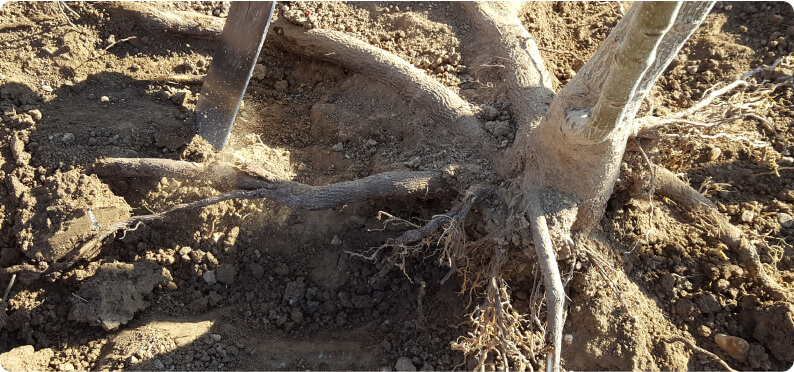
It has a thin plate, light gray color, smooth surface, with visible lenticels (in young trees), and usually looks cracked or lacerated depending on the age of the tree.
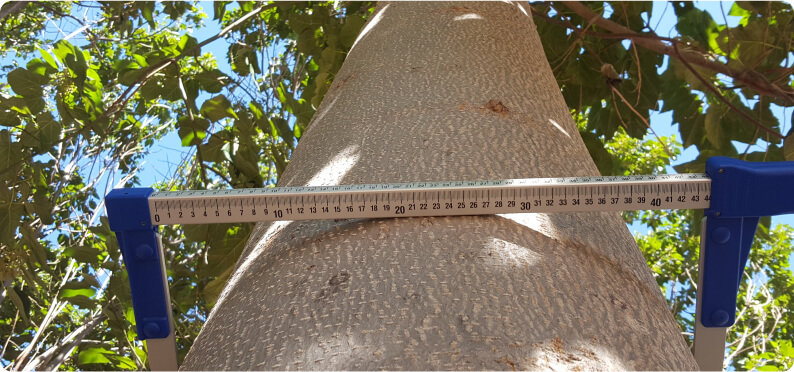
The trunk is straight, its diameter within the first years of life can measure around 14 centimeters. Upon reaching maturity, it thickens considerably, measuring up to 80 centimeters after 18 years of age.
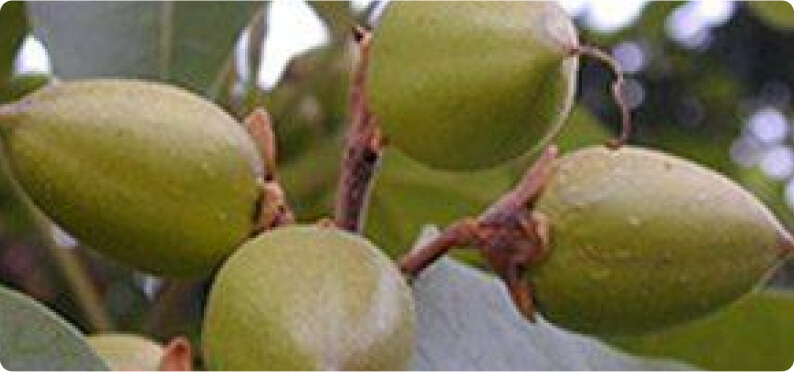
It is a loculicidal capsule with a thin or thick and woody pericarp. They are hook-shaped and can measure around 10 centimeters.
The Paulownia is a tree exceptionally resistant to heat and drought conditions . It only requires controlled watering during its first two years of life. Water consumption per seedling is 30 to 40 liters, watering them 1 or 2 times a week. From the third year onwards, when its root system develops, it does not require any special irrigation system.
Although all of the aforementioned are characteristics that are shared by almost all Paulownia tree species, it is important to highlight that the tree can vary in one or more of these aspects. The environment, climate and conditions in which it is planted can influence, although not to a large extent, some differences.
Due to their characteristics, the different varieties of Paulownia can adapt very well to different terrains. Its planting is not aggressive with the environment, it has the ability to prevent soil erosion and contributes to its regeneration. It is a producer of pulp, forage and honey, in addition to being considered an oxygen factory. It grows and gains volume quickly compared to other types of trees and results in a very showy and beautiful plant frequently used for landscaping.
Its beauty, along with the properties of its wood, its leaves, its fruits and its flowers, have properties and qualities that we can take advantage of and market in different areas. Let’s talk a little about how to take advantage of this fascinating plant.
One of its most interesting qualities is its rapid growth ; there is no other species in the world whose documentation suggests growth similar to that of Paulownia. This growth is around 1 cubic meter at 7 or 8 years, which is a small treasure for humanity: helping to regenerate and stabilize the soil, fighting erosion and absorbing carbon dioxide, producing oxygen in its place. A single tree is capable of absorbing 22 kg of carbon dioxide and producing 6 kg of oxygen, a figure that calls for consideration about the benefits of its cultivation.
Once good quality Paulownia seedlings are acquired , their strong and resistant root system makes them capable of growing even in infertile, clay or sandy soils.
Its large leaves provide dense foliage ideal for providing shade in rest areas, parks or squares. Paulownia represents true plant lungs for cities affected by pollution and toxic gas emissions, in addition to creating pleasant fresh corners.
The leaf mass of Paulownia, that is, its leaves, are commonly used as forage to feed cows, sheep, goats, etc. Its qualities are far superior to that of alfalfa, an organic material frequently used for this purpose. Containing about 22.6% to 27.1% crude protein and about 12% hay. Its leaves are saturated with microelements and its digestibility is 60%.
The highest protein content is found in one-year-old specimens. Therefore, if Paulownia is used with the main objective of obtaining biomass to feed livestock , it is advisable to create a separate plantation and collect quality content at the end of summer where the leaf reaches the highest peak of crude protein concentration.
Paulownia cultivation technology for forage production will allow receiving between 35 and 40 tons of quality plant raw material , per hectare, per year. Its performance and availability leads to a low cost of this type of food, a factor to consider when choosing forage for industrial livestock farming.
It has been established that Paulownia leaves contain substances that positively affect the functioning of the bladder, liver, kidneys and gallbladder, as well as help with lung problems. In China, these properties have been recognized for a long time and even the pharmaceutical industry is dedicated to the production of medicines based on this plant.
Its leaves also have other properties, in Asia, its use in the Cosmeceutical industry is as old as its application in medicine. However, it is a novelty in Europe; In recent years, the extract of Paulownia leaves has been included in the composition of medicines, creams and perfumes.
Upon awakening from hibernation, in February-March, Paulownia produces bell-shaped flowers up to 6 cm in diameter each, bluish violet, purple or almost white. Its aroma (aromatic notes) is defined as vanilla, powdery and slightly almondy. This is because the fragrance contains a substance called piperonal or heliotropin , well known in perfumery and present in other aromas (for example, in Tahitian vanilla).
The analysis of the aroma of Paulownia in flower is carried out by a method called “GC mass spec”, based on mass spectrometry to identify different substances within a test sample.
The flowers, in addition to their beauty, are also excellent honeycombs! From one hectare of Paulownia it is possible to collect more than 800 kg of honey . The advantage is that when growing Paulownia wood , no chemicals are used, so the bees that do not tolerate the use of insecticides and other chemicals are not harmed, receiving a completely natural product.
Paulownia honey is light, transparent, very clear and aromatic; Due to its color and consistency it can only be compared with acacia honey. Paulownia honey, like acacia honey, is one of the highest quality honeys . In addition to being a delicacy, it can also be used medicinally. It is well known for its beneficial effects and as part of the treatment of bronchial, lung and respiratory system diseases, and also improves the function of the gallbladder, liver and digestion in general.
The qualities of Paulownia honey are determined by the substances present in its flowers, so it is okay to use the same flowers in food. In addition to the Chinese experience in this sense, we must not overlook the fashion of using Paulownia flowers in the form of cones filled with cream which, although it may seem like an exotic dessert, is already part of the menu of many European restaurants.
Biofuel, Biogas and Bioethanol
Biofuels are made from oilseed plants, such as sunflower or Paulownia. That is, they are fuels derived from organic sources and/or organic waste; some examples of biofuels are bioethanol and biogas.
With the increasing consumption of biofuels, in the near future, the forest resources of Central European countries will not be sufficient to cover all demand. Therefore, Germany, Holland, the United Kingdom and Spain plan to significantly increase imports of wood pellets, solid fuel made from compressed wood.
Today, when technological progress is measured by the degree of protection of nature, energy culture is giving more and more importance to biofuel from highly profitable renewable energies. The use of Paulownia in the energy industry as a resource can occur both in the form of pellets and as raw material for alternative biofuels.
For this purpose, all parts of the tree are used: trunk, branches and leaves. Pellets can be used both for boilers that supply private homes, as well as for large installations and electrical networks.
Biogas is a new ecologically and economically viable renewable energy source. It is a gas basically composed of methane (CH4), carbon dioxide (CO2) and small proportions of other gases. It is produced from the fermentation of organic matter under anaerobic conditions (absence of oxygen).
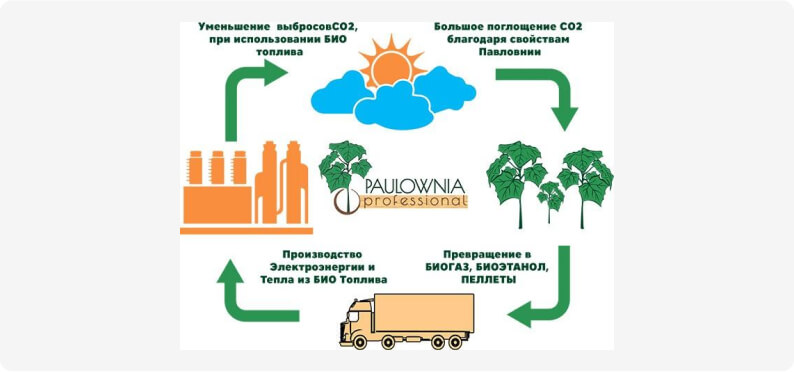
A biogas plant is a facility where the natural decomposition cycle occurs at an accelerated rate. Paulownia leaves are increasingly being used as a component of the organic matter of this biofuel. Being large in size, its decomposition produces a greater amount of the main gases that make up biogas, compared to the organic material offered by other types of plants, making Paulownia the ideal specimen for obtaining this biofuel.
Paulownia can also be used as raw material for the production of bioethanol. American scientists have developed a new technology based on the combination of thermochemical and biotechnological methods, the result of which is the extraction of 511 liters of ethanol for every ton of dry wood, which is why our tree is often called an “oil well.”
The creation of fast-growing timber plantations, together with innovative technologies for growing Paulownia trees, could become an important part of resource-saving policies, in addition to solving problems related to energy consumption without risk to the environment .
Uses of Paulownia
Paulownia wood is characterized by being 100% ecological, resistant, soft, light, resistant to fire and humidity, resistant to warping and pests, in addition to being rot-proof. Paulownia wood has a straight shaft, with a beautiful and intense design with straight fibers, with a granular and shiny texture. The color of the wood ranges from pale yellow to light red. The beauty of the wood structure is similar to that of expensive exotic woods. The cultivation technique causes the trunks to grow straight and without knots, which generates top quality wood.
It is a very good raw material for cabinetmaking and carpentry in general. With its characteristics and infinite advantages, Paulownia wood opens the way to new dimensions and possibilities in the production of innovative furniture. It is a soft and light wood, but extremely resistant to bending and twisting. Due to this excellent strength-to-weight ratio, with an average weight of approximately 208-300 kg/m3, it is one of the best materials for construction. Since these materials require high strength, for example, poles, which support building structures.
The compressive strength index of Paulownia wood fibers is 281 kg/cm2. It is an easily malleable material and valued by experts due to its softness and stability. This wood accepts paints, varnishes and adhesives very well, and as it is water-repellent, it contributes to more economical consumption of these products. Objects made from this wood are not altered by changes in atmospheric conditions, which do not affect the shape or size of this material, which also explains why it is a rot-proof material.
Currently, it is actively used for the construction of houses, due to its rapid drying without deformation and its high resistance to fracture. From Paulownia wood , blinds, stilts, beams, ceilings, decorative beams, parquet, covering materials, window and door frames, as well as any type of furniture are made. The combination of its resistance to fire and deformation makes it the ideal material even for the most complicated sawing.
All types of Paulownia grown for commercial purposes are clones. This means that they are identical plants with specific characteristics. The species most commonly used in the timber industry are hybrids based on Paulownia Fortunei and P. Tomentosa . The first is endowed with fast growing properties and high quality wood, and the second is known for its resistance to cold and its ability to develop in areas where winter temperatures reach -10º C or less.
Along with these hybrids, Paulownia Elongata and its hybrids are used, which also gives excellent results, although we must take into account the fact that it is also thermophilic.
It is lighter than the lightest wood known so far: balsa wood. Its average weight is 208-300 kg/m3. Despite its lightness, it is extremely resistant, a combination that plays an important role in sectors such as shipbuilding, aircraft construction, production of surfboards, skis, snowboards, production of motorhomes and other products. Easily malleable.
It is very valuable as a material for boxes or transport pallets, since it reduces the total weight of the load. This makes it possible to reduce fuel consumption, increase the volume of transported products and, in general, leads to a decrease in transportation prices, which is the main objective of companies dedicated to logistics.
It perfectly supports nails and screws, and does not require pre-drilling holes. For example, only yellow poplar and white pine show a lower degree of decoupling than Paulownia. Flat head screws can be screwed perfectly flush with the surface of the material, without causing any damage, even if this is done at the edge end of the piece, making it the ideal material on which to carve.
Its properties reaffirm that it is the ideal material for a number of uses.
The same property that allows the Paulownia tree to be resistant to high temperatures is what gives one of the most valuable properties to this material: its resistance to fire. It burns at a temperature twice as high (400°C) as the flash temperature of most woods. In ancient times, the Japanese made their wardrobes out of Paulownia to store their valuable kimonos in case of fire.
The tannins present in Paulownia wood are responsible for its resistance to insect attack. These compounds are developed by the Paulownia in life and have the property of being astringent and interfering with the absorption of nutrients, which gives the Kiri tree protection against herbivores and insects. Therefore, this wood is also resistant to attack by termites, woodworms, carpenter ants and other insects.
Billions of air pores make this wood an exceptional material as a thermal and acoustic insulator, incomparable with any other. This quality is especially valued in the manufacture of saunas, cabins and interior and exterior cladding and insulation.
The position of the molecules that make up Paulownia wood gives it resistance to humidity, it is classified as a water-repellent material. That is, it has difficulty absorbing water. Furthermore, changes in atmospheric conditions do not affect the shape or size of this material, which explains why it is a rot-proof material.
In places where it is grown and produced, the commercial value of Paulownia wood is very low compared to other similar materials for sale. The price/quality ratio of this wood makes it ideal for all types of construction and carving projects. Its price could also vary according to the origin and quality of the wood, which will be determined by the final use it will have.
Today, Paulownia is a plant that is as interesting as it is unique. Numerous research suggests that the use and exploitation of each part of this tree due to its unparalleled characteristics, represents a new alternative to everyday needs.
Paulownia Professional® is available to answer your questions.